“Pattern and Decoration” (P&D) is the name of an art movement that had its moment of visibility in the post-modern pluralism of the 1970’s and 1980’s. Its practitioners include Valerie Jaudon, Miriam Schapiro, Joyce Kozloff, Kim MacConnel, Tony Robbin, Robert Kushner, Robert Zakanitch, and many others. P&D often serves as an unheralded theoretical base for the quilted arts that I am familiar with.
Robert Zakanitch, Red Watercolor, 34 x 36, 2007
Pattern and Decoration: An Ideal Vision in American Art, 1975 –1985 is the printed catalogue of an exhibit held at the Hudson River Museum in 2007 -2008. The catalogue has excellent essays by Anne Swartz, Arthur Danto, Temma Balducci, and John Perreault, as well as including short biographies of the artists and plates of the exhibited art. Most of the words which follow come from the catalogue.
The P&D catalogue gives a textual underpinning to formats and surfaces that we enjoy but have come to think of as “mere” decoration. Arthur Danto, for example, says that decoration fell somewhere between figuration and abstraction and “encompassed almost the entire visual culture of many non-Western traditions…. The impulse to decorate was the impulse to humanize.”
Miriam Schapiro, The Kimono, 1976, 60 x 50, acrylic and collage on canvas
According to Danto, the P&D artists were already using decoration before the movement was created, and what naming it did was to “enable its members to recognize what they had in common.”
Joyce Kozloff, Tile Mural for Harvard Square Subway, 1985 -86
Danto is the eternal optimist, claiming that P&D is easily a third mode of art making, and that “formalism ought easily to apply across the boundaries to all three categories of art, had it not been weighted down with prejudices that had little to do with its essential practice….. It is not difficult to suppose that there are three modes of embodiment:” i.e. figuration, abstraction, and decoration.
The P&D movement is obscure, but the impulse, to make pattern, to decorate the environment with beauty, seems universal, perhaps too common to be seen as on a par with the usual high-art suspects in western art history. Moreover, P&D often lacks irony, a form of expression that dominates almost all art these days. [I’m thinking of D. and the whole LA scene right now….]
Tony Robbin, Coll: the Artist, 2007–4, 56 x 70″
Critics of P&D had to come up with convoluted reasons for rejecting it, although some of the rejections (too pretty, too feminine, too serious) weren’t too hard to come by. But Donald Kuspit in a 1979 article “Betraying the Feminist Intention: the Case Against Feminist Decorative Art” in Arts Magazine felt that “art based on decoration betrayed the critical potential and intention of feminist art.” It apparently was too close to formalism in its theory and therefore, “too authoritarian.” But what is most fascinating is Kuspit’s later “confession:” He felt, he said, that he needed to “rationalize my enjoyment of Rober Kushner’s art … compelled to apologize intellectually for the deep pleasure I take in it…”
Robert Kushner, Night Garden, Acrylic,Oil,glitter, gold and silver leaf, 60 x 60, 2000
Anne Swartz, the chief contributor to the essays in the catalogue as well as the curator of the exhibit, says “I suspect that until recently, a certain Puritanism surrounded the view of feminist art that prevented it from being seen as acceptable when it was sexually exciting and provocative. So when P&D art utilized some of the mechanisms of feminist art (provocation, pleasure, softness, etc) it challenged the intellectual systems that were supposed to be uppermost in the viewer’s mind, prompting a critic like Kuspit to repudiate the intentions of P&D as not supporting the utopian notion of feminist art as a sterile ideology.”
Swartz also speaks of the “bombastic approach of the new-expressionists…. It [P&D] wasn’t self-referential…and [had] an overall treatment of the surface.” Kim MacConnel said to Swartz, “P&D is nonhierarchical in the sense that it is not refining itself to an end point and time…. It is much more chaotic. It is open to different voices, it accepts different voices, it’s making different voices.”
Kim MacConnel,Tri-Rotating, Acrylic on canvas, 95 x 126, 1980
I’m fascinated by the theoretical underpinnings of this artistic movment,especially the constructs of “non-self-referential” and “non-hierarchical.” aAlthough I’ve moved far away from Pattern and Decoration in my own work, I still love it and so, perhaps, am looking for the verbal language which would allow me to speak more “authoritatively” about it. But reading and looking at these materials also makes me think I could incorporate P&D into my own vision. One artist, Leslie Gabrielese, serves me as an example:
Leslie Gabrielse, Dancing on Top of the Mountain, 60 x 130, 2001, fabric and acrylic paint
I am a bit bemused at how enthralling I found the textual materials in this catalogue. There’s nothing like having one’s prejudices confirmed, I guess. Aside from the art and perception in this post, when you examine your work history, have you found at one time or another some verbal explanation that seemed to capture something about a visual that you had but couldn’t explain? Something that enabled you to recognize what you had in common with other workers in the same modes?
The catalogue, by the way, is Pattern and Decoration, and is online as a Google book. The Google pdf version cannot be printed, but you can order a hard copy from the Hudson River Museum, Elizabeth A. Sol, Manager of Administration & Visitor Services, The Hudson River Museum, 511 Warburton Ave. Yonkers, NY 10701 Phone – (914) 963-4550, ext. 239 Fax – (914) 963-8558. The museum doesn’t seem to have a secure online server, so I ordered my copy by phone. A good slide show of the works (many of which couldn’t be included in the Google online version) can be seen in the NY Times . Here is the accompanying Times review.
I apologize for the slightly formal tone of this blog entry — I’m still assimilating the language appropriate to P&D and so find myself less easy about explaining it. But here’s one last image that I found, all on my own, to continue the dialogue:
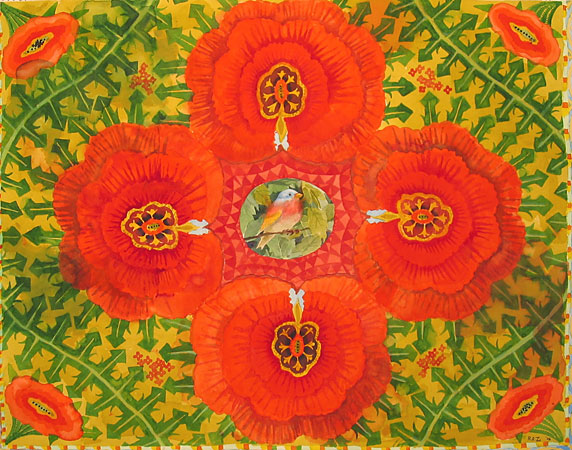
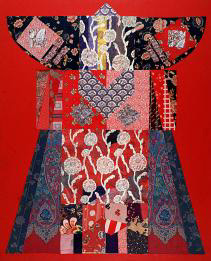
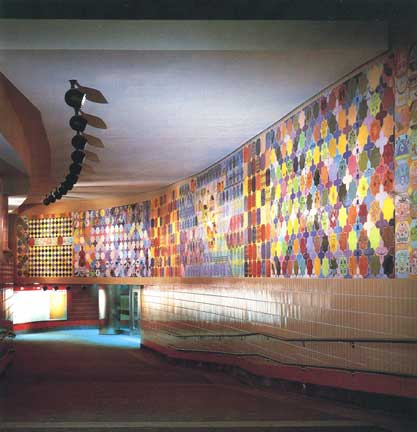
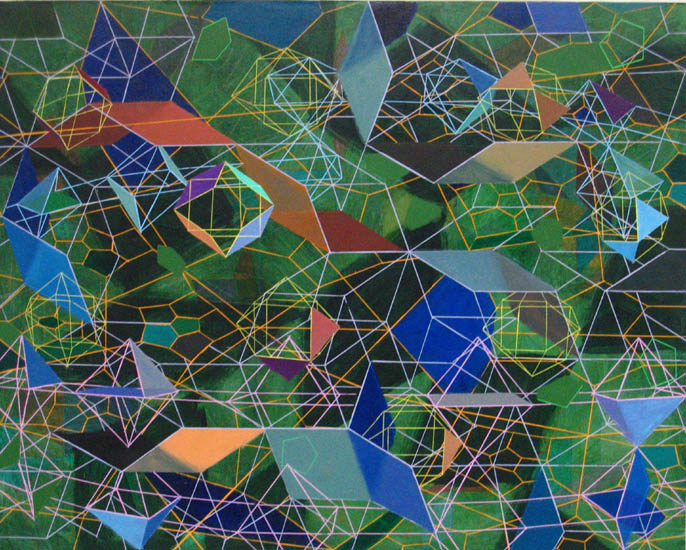

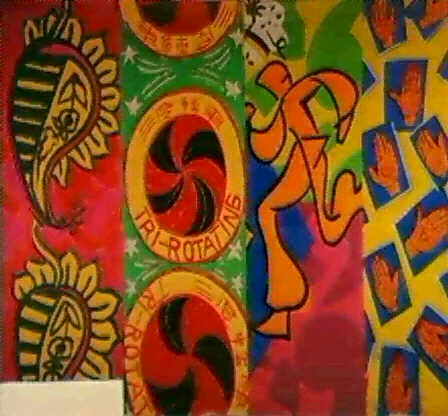
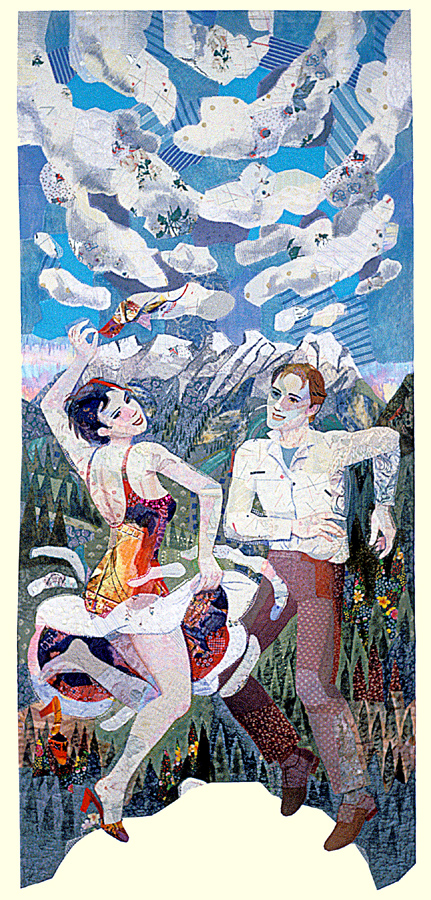
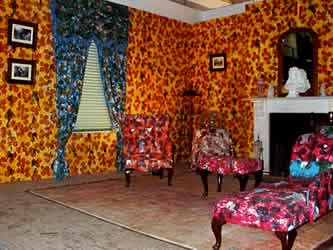

Love the piece. More on P&D!
Out of the shadows, please.
Thanks, Jennifer,
What I found most interesting about the articles on P&D was Danto’s comment that this form represented one of three basic modes of artistic presentation — figurative (representational), abstract, and pattern and decoration. That blew me away, it’s so fundamental.
June,
Thanks for introducing P&D, it’s something I was unaware of. The Danto dictum does seem profound, but, though unfamiliar, doesn’t feel wrong to me. Imagining times I’ve done something I’d call decoration, it does seem like a different attitude adopted. Somehow the decoration has less weight and doesn’t need to “express” anything, though inevitably it does in some way.
I find the colors in Red Watercolor quite striking, but I have to confess I’m not especially drawn to any of these artworks. I find the kimono the most interesting, no doubt because I spent several years in Japan puzzling over the very different approach to color and pattern, particularly in clothing. It was very common to combine things that wouldn’t be thought to “go together” by most westerners.
Like you, I find it tremendously satisfying to find that someone has put into words something that jives with–or challenges in a clear way–something I haven’t been able to articulate. I can’t point to a particular instance at the moment, but I know it has happened for me on A&P, sometimes from you yourself!
Steve,
Because the category P&D is so large, equivalent to abstract/representational, it’s bound to cover a lot of ground that I (and you) don’t care for. It only makes sense. We both like specific abstract art pieces and representational pieces and don’t like others.
Your observation about things “going together” is very interesting. For example, Japanese kimono makers had no interest in making their fantastic patterns wrap around the sides. So the kimonos could have two similar patterns that didn’t “match” at the side seams because “matching” at the sides in clothing wasn’t an idea that concerned them. Matching on their store cloths, “norens” on the other hand, was crucial. We can’t even imagine having P&D as our store logos, let alone ones designed and dyed in indigo that, although pulled into two halves, made perfect circles and perfectly aligned design.
The difficulty with P&D is that it gets confused with (forgive me) home decor (and the Japanese noren isn’t any help in this regard) — where whatever colors/patterns have been decided upon as being in and “going together” at any given time are decreed to be set in stone — but only for the year. Home dec is a marketing device and has built into it the construct that this year’s colors, etc., will be obsolete and lack harmony next year. P& D has to overcome that construct without simply falling into opposing it.
Obviously the muslim countries have not had to deal with home dec as an obstruction and the Japanese Noren weren’t marketed until fairly recently — and many other cultures have P&D as ancient cultural artifacts. But in America, it’s as if a big glass wall with lots of instructions written on it obscure what we could recognize and love or hate or be indifferent to as P&D art.
Or so it seems to me after a long day and two glasses of wine. Thanks for checking in.
June,
Looking at the last image, makes me feel acutely uncomfortable.
Growing up in wall-papered rooms, I used to dream of living inside chalk white walls such as found in a cloister. I love texture in nature, but not pictorial noisiness where I live.
In small amounts, I can appreciate the intricacies of pictures such as ‘Red water color’, ‘night garden’ and tri-rotating.
Why do we put labels on activities, herding instinct?
Birgit,
I too like my built environment on the spare side. Yet sometimes I walk into my house and it feels cold and empty rather than crystalline and clear. So maybe the grass is always greener…..
Re “labels” : I myself find that labels help me make sense out of my world, or the world I’m trying to comprehend. Without words, which are the most basic form of labelling, chaos overcomes my ability to think — but when I can sort things out, “label them” if you will, I can move through the environment with a kind of understanding that the former chaos didn’t allow. Different labels? Different understandings. The more the better.
It’s probably temperamental, but, for example, when I discovered the pigments and their names (as opposed to the fashionable nonsenses of “planetary green” or “pink posey”), it was as if suddenly i could see those colors– burnt sienna, alizaran crimson, cadmium yellow pale, ochre, viridian and on and on. And then, having gotten the basic “pigment labels” fixed as part of my color vocabulary, I could expand them — viridian with a touch of ultramarine violet; gold ochre mixed with raw sienna.
So I like labels and concepts and generalities, beginning with words. I don’t exactly believe in them — that is, I don’t think that we have found all the labels and sortings that humankind needs — but I do think that labels allow us to think, and if we are open to new labels, we can think more broadly. And then the brilliant among us will give us one more label, and another door will open.
So, like comparisons, labels are just one means of sussing out the world around us. Like comparisons we can use them well or badly; we can be outfoxed by them or we can do end runs around them. But I suspect we can’t deny their usefulness.
So maybe it’s a herd instinct — a smart herd…..
June,
A chemical distinction, name of a pigment, is not the same as the human desire to belong, to fit in.
Mixing gold ochre with raw sienna, what a great idea!
I think a label, in colloquial speech, is often just a prejudice. But used well it is a generalization, a hypothesis, and therefore tentative. We say “oxygen” if we don’t know or care about isotopes, “air” if we don’t know or care about elements. “Pattern and decoration” may be a useful label if it helps explain something about the production or effect of something we problematically label “art.” It might help us understand, for example, the place of all those patterned and decorated vases and baskets in art museums.
June:
Thanks for bringing up this subject as it is a yeasty one.
And, the questions of definitions and what rises to what level touch home, even though I have never sewn – except for that strange sateen shirt I made in grad school. I’ve shared some questionable projects on A&P: x shaped things and chains that seem caught between categories. Sometimes I have to be content with having made something that dresses up a wall, and leave it at that. But the ambition to create something that rests unambiguously in my eye as art is always there.
Birgit:
You used the term “belong” and it touches something important. A lot of people these days are serious about being creative. Pursue the matter purposefully and one can encounter difficulties: disappointment in one’s own results, lack of attention and appreciation from others – a brass ring that is just out of reach. One looks to and for others with whom one can communicate and perhaps draw strength. One might seek validation in the group, and the group itself validated as part of a greater and respected whole. It certainly applies to me.
Steve:
Makes me wonder if the Japanese have a tradition of artistic labels? In the West it’s as though pillars are engraved with terminology like “abstract”, “constructivist” and, instead of being set along side the road as mile markers, are thrown across it to trip and impede.
And, for me, the term “decoration” is something of a diminutive and begs not to be taken seriously.
Yuck! I got totally sensitized to patterns. An innocent kitchen towel has suddenly become an object of my wrath and is distracting me.
Listening to an interview on Financial Times, I was distracted by the two gentlemen wearing patterned ties. Help!
Jay,
You are right, support is important but why does it have to be homogeneous? I am being supported by my ceramicist friend, I am supported by you while my approach to art is different from the two of you.
And, no post from me this week, my writing mind has to recover from writing excess in my day job.
Birgit:
Sometimes it feels like there’s two of me.